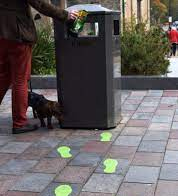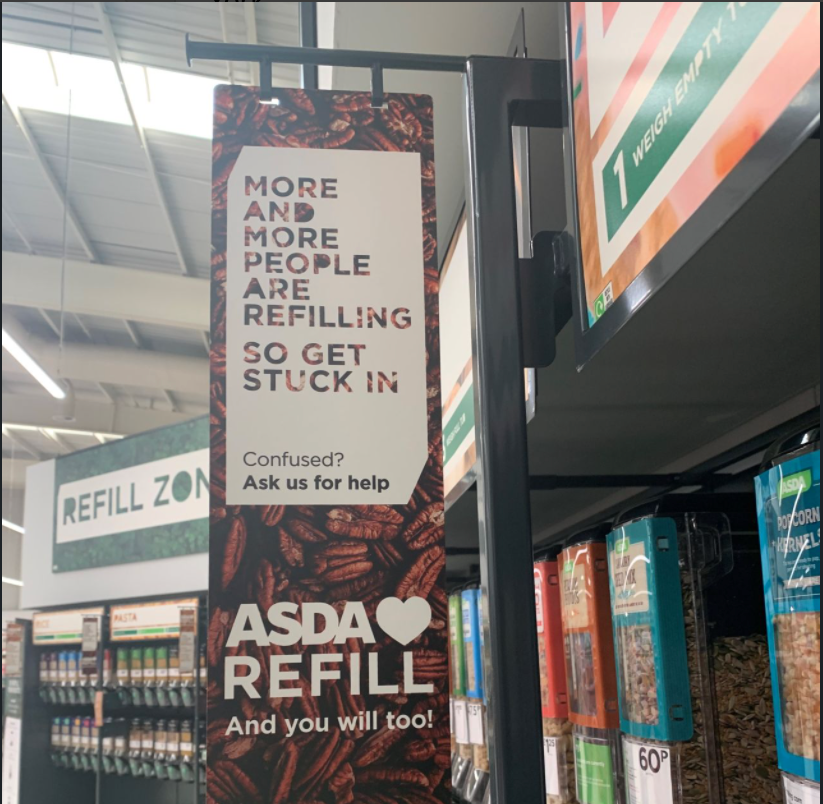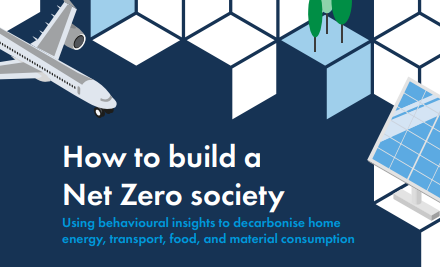Net Zero relies on behaviour change. According to the UK’s Committee on Climate Change, the majority of future emissions reductions – 63% – will need to come from changes in how we travel, how we power and heat our homes, what we eat, and what we buy.
But, what does that really mean for the day-to-day? What can we actually do to help in the fight to decarbonise? Not such a silly question when you consider that 83% of people in Europe can’t identify what green behaviours they need to carry out, or that the UK public really struggle to accurately rank different green actions based on their impact (people actually perform worse than random!).
We’re often the first to point out that ‘information alone isn’t enough to drive big changes in behaviour’ (particularly where big cost or convenience barriers exist). But, with such a large shift in public action needed, and a lack of strong public understanding of green behaviours, it’s clear that public engagement, information and effective communications are a vital foundation.
We have been working with the Welsh Government and SBW Advertising to develop 11 evidence-based Principles for Climate Change communications for behaviour change.
11 Principles of Climate Change Communications for Behaviour Change.
A comms campaign can serve a variety of purposes: from building trust in Government, to shaping public awareness around green choices and upcoming policies, as well as directly encouraging green actions among the public. Borrowing from the Welsh Government’s own “4 E’s Framework for Net Zero Public Engagement”, comms can be harnessed to Exemplify action (e.g. highlighting what’s being done), Engage people with the issue, Enable change (e.g. providing tips or signposting to policy support), and Encourage greener choices with direct calls to action.
But when using comms, what specifically should you say, and how should you say it? We summarise 11 tips which emerged from a recent evidence review on this topic undertaken for the Welsh Government in partnership with SBW Advertising, organised within BIT’s EAST framework.
Below, we bring these principles to life:
EASY
People are confused and overwhelmed about their role in Net Zero – 83% of us are not certain what green actions we should start with. Studies show that making green choices as easy as possible helps people to engage – for example, i) making green energy tariff options the default (thus making the green choice the easiest option to choose) increased uptake ten-fold, and ii) making green diets easy to access (by doubling the availability of veggie meals in canteens) increased vegetarian sales by between 40 – 80%. So how can we make climate action easier just through comms?
#1: Provide clear and simple messages, with intuitive and familiar metrics. We do not have unlimited cognitive bandwidth. We remember simple messages more accurately and are more likely to act correctly if they’re clear. Therefore green communications should be short, punchy, and easy to digest. Communicating clearly and simply also involves using metrics that the public can understand – for example, studies have shown that people are more likely to understand information when it is presented with relatable and familiar analogies (e.g. presenting kcal as ‘minutes of exercise’, or kWh as running cost), or personally relevant examples in messaging that are not psychologically distant (e.g. talk about local impact of climate change: local species decline and flood rather than distant melting ice caps or polar bear extinction).
#2: Use action oriented messages that tell people WHAT to do and HOW. Given the lack of knowledge that people have about i) what green actions to prioritise and ii) how to do them, providing clear calls to action and ‘procedural (how to) information’ is key. Explain specifically what to do – e.g. visit a webpage; swap driving for the bus; eat less meat and diary, and how – tips, recipes, meal plans. Manchester City’s green diets campaign, below, does a good job of the former. The recent DESNZ campaign showing people how to people to turn down their boiler flow temperature) did a good job of the latter, with step-by-step videos modelling the action.This principle can also be demonstrated by the clear visual labelling on recycling bins (below). It’s not just imploring people to recycle more – it’s addressing a real knowledge barrier to make the correct action easier (and indeed, data suggest it can increase self-reported recycling knowledge by up to 88%). We’re fairly accustomed to seeing this approach with recycling, but it’s surprisingly absent among many campaigns telling us to take other vague or complex actions – like switching to a heat pump, or cutting our food waste.
(1) Manchester City Council’s green diets campaign, and (2) Recycling labels clearly depicting what can be disposed of.
ATTRACTIVE
When green choices feel desirable and salient, people are more likely to do them. Many green choices are perceived to be quite unattractive, from plant-based meat alternatives that are associated with being less tasty to electric vehicles being perceived as expensive or inconvenient. Others just might not be on our radar against a back-drop of habituated consumption and a busy life. To make green choices feel attractive and visible, your campaign should:
#3: Make it salient and visible. People attune their attention toward stimuli that are salient, unexpected or novel, and so climate communications should be just that. For example, hand-written letters increase response rates by around 20% because they are a relatively novel prompt, just as adding a green stripe on electric vehicle number plates acts as a new prompt for sustainability (see below). Equally, alluring prints on bins significantly increased recycling by up to 25% (e.g. cow-prints) and adding playful green footsteps leading to bins reduced littering in the Darlington UK by over 15%.
(3) Green number plates of EVs in the UK are salient visual indicators of a green choice, (4) Green footsteps in Darlington leading to bin
#4: Emphasise co-benefits of a green choice but pick the right framing. Environmental motivations are not always the main motivations that people have for being green, and emphasising personal co-benefits of a green choice can have a bigger impact. For instance, emphasising the co-benefits of Net Zero increases the amount people are willing to donate to climate protection causes by about 10%. Selecting which co-benefit to advertise can be tricky, and its success will depend on the target behaviour context and target audience. But, some examples can include emphasising Net Zero around public health benefits, national energy security benefits, economic benefits and green job benefits. Below, we show how the Sustainable Energy Authority of Ireland promotes retrofitting by highlighting the comfort benefits of it, rather than the environmental one. Indeed, further BIT research showed that framing heat pumps around ‘heating that works’, ‘energy security’, and increased ‘property value’ increased people’s intentions to buy them more so than messaging about their environmental benefits.
(5) Sustainable Energy Authority of Ireland’s retrofitting campaign
#5: Harness existing community values, rather than forcing ‘green identities’. Climate communications that speak to people’s existing and established values can be very effective, often above those aiming to instil new green values. Namely, public approval and agreement with a policy is increased if it is framed around common values of fairness, morality, impact on community and safety, inter-generational duty, and around the values of avoiding waste and cost saving. The seminal ‘Don’t Mess with Texas’ campaign is a good example of a campaign that harnesses Texan’s pride and patriotism to reduce littering.
#6: Avoid blame or scaremongering. Fear, stigma or guilt-based environmental messaging can backfire, as it makes people feel demoralised and avoidant. Although fear messages receive high engagement on social media can be associated with pro-environmental behavioural intent, other studies find that triggering positive emotions (e.g. gratification) is more effective than guilt.
SOCIAL
With all green choices, people are more likely to behave sustainably if it is perceived as the normal, socially accepted thing to do. For example, when people can see that their neighbours have solar panels they are 44% more likely to get one themselves because it’s seen as the norm. How can a comms campaign make green action feel social?
#7: Lead by example to build legitimacy. Strong and credible leadership makes a difference when it comes to communications. Governments should lead by example through their own behaviours, through public procurement, and through long-term policy commitments to build trust and legitimacy. This sends powerful signals about norms and intentions, and can have a meaningful impact on action. This was demonstrated by a Japanese Government communications campaign (CoolBiz), that promoted energy efficient behaviour in offices by the prime minister and members of Cabinet wearing loose-fitting short-sleeved outfits in formal settings to normalise having office air-conditioning on lower settings. This campaign resulted in an estimated 1.4 million tonnes-reduction in CO2 emission since 2005.
#8: Harness effective messengers: different groups listen to different people. We are more responsive to environmental messengers that we trust and that we identify with, so endorsement from key (trusted, credible, expert, and legitimate) messengers is key for Net Zero. Importantly, this varies for different segments of the public. The Government’s ‘One Step Greener’ campaign is an example of a campaign that speaks through a diverse set of (26 different) messengers to reach different demographics across the UK – spanning youth activists to voices for Muslim women and women of colour, and spread across a variety of roles (TV hosts, influences, NHS staff).
#9: Advertise and model social norms. Presenting people with information about positive social norms can significantly increase uptake of green choices or behaviours. For example, communicating to energy customers by comparing their energy use to that of their neighbours can reduce energy consumption by 2%, and prompting recycling with on-pack messages (saying “Most people recycle me”) can increase recycling by 7% (see examples below).
(6) Social norm prompting recycling; (7) ASDA refill social norm prompt.
TIMELY
With all green choices, people are more likely to behave sustainably if they are prompted at the right moments. For example, helping people to plan their time makes them 5% more likely to commute to work sustainably, and SMS reminders help increase active travel too. To make a climate communications campaign more timely, you should:
#10: Use prompts at timely moments (e.g. point of purchase, transitions). Prompting people at key moments of a user journey can make a real difference. For example, eco-labels can play a key role at shifting customer action if made salient at the point of purchase. In a BIT experiment ran with DESNZ, prompting people with ‘lifetime running cost’ of an electrical appliance at the point of purchase increased green choices by up to 14%. Another key moment in which people change their habits and choices are transitions that interrupt their typical patterns of behaviour (‘moments of change’) and provide a unique window for a re-set (e.g. moving house, when a car breaks down, or when boiler malfunctions). In a BIT trial, communications about a bike-share cycling scheme were 4-times more impactful when delivered to people who had just moved into the area.
#11: Make use of reminders and frequent prompts. Communications campaigns can involve sending reminders via SMS or letter to shift actions. For example, a timely mobile alert asking Californian residents to use less energy to avoid a power black-out helped to reduce energy demand from its peak at 47,357 megawatts by 1.2 gigawatts. BIT also studied the impact of prompting EV purchase on the DVLA website whilst people paid vehicle tax, finding that a timely reminder increased traffic to the Government’s Go Ultra Low website. Moreover, the frequency and length of exposure both make a difference – single exposure to environmental messaging is weaker than longer exposure. For instance, farmers viewing more stimulus about sustainable agriculture used up to 60% less fertiliser and pesticides, which damage the environment.
Overall, communications campaigns are a crucial part of the Net Zero puzzle, and public engagement, education and encouragement form key pillars for enabling people to make greener choices. It won’t be enough – substantive policy changes are needed to make green choices cheaper, more accessible and more attractive. But comms can even support this too, ensuring policies are framed and communicated effectively, seen as fair, and cut through to the public’s awareness so they can access the help on offer.
We hope these 11 principles give you a solid foundation on which to build your own campaigns, but we encourage you to reach out to the Behavioural Insights Team if you are interested in further collaboration on climate communications for behaviour change.












